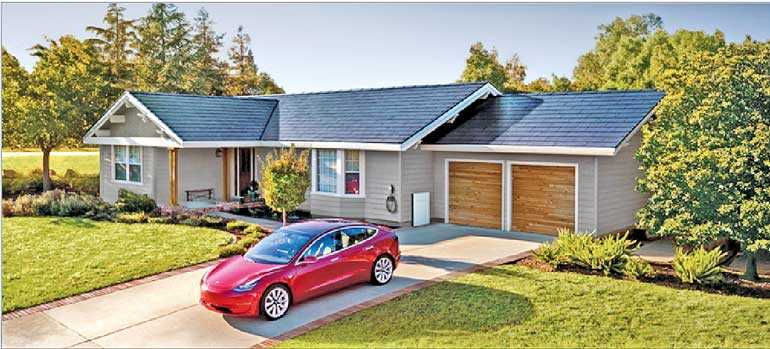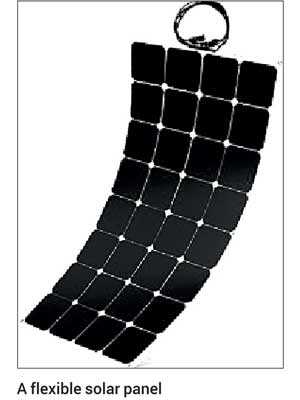Monday Nov 17, 2025
Monday Nov 17, 2025
Tuesday, 20 October 2020 00:23 - - {{hitsCtrl.values.hits}}

Solar tiles installed seamlessly on a roof – Pic from Tesla Inc. website

Solar panels for traditional tile roof

Seamlessly integrated roof panels
Sri Lanka does not have a credible reputation when it comes to reliable supply of electricity to the masses. The most notable drawback has been the very frequent planned power cuts and intermittent supply failures that have been happening year after year during the last several decades.
The other issue is the high cost of electricity compared to the general cost of living. Citizens have been faced with an unreliable electricity supply system at a very unaffordable price for far too long. Sri Lanka’s slow and erratic march towards a viable energy policy has and will hamper economic growth as well as the reputation among foreign investors and tourists. 
Solar energy harvested as electricity using Photovoltaic panels (PV panels) are a highly suitable source not only to satisfy immediate needs at the household level but also to be sold to the national grid to support its capacity. This technology is not alien to Sri Lanka but sufficient penetration of it to make a meaningful difference is lacking. Here, we discuss the advantages of PV systems and propose some possible avenues to popularise the widespread use at a national level. At a minimum, it is very possible that at least half of the households setup just one or two low wattage panels and a battery system for their own use during the power outages.
Further to the use of solar electricity for home/office lighting purposes, there are myriads of practical ways to use solar energy. Some of these are; building ventilation (both for comfort via ceiling fans and heat exhaust roof fans), self-powered street lights, road signage for speed control, safety notices at road construction sites, pumping well water for irrigation of fields, etc.
Also, following the advent and popularity of LED lighting systems which efficiently operate at low voltages, solar light powered greenhouses have become extremely popular in many countries. This technology offers year-round organic gardening opportunity where insects and weather effects can be completely controlled.
As a point of contention, during the last 40 years that I have been living in Canada, I can recall only about five power interruptions. Most of those lasted only several minutes each time, unless due to extreme weather events such as freezing rain or violent thunderstorms. This is what can be achieved in a well-managed and efficiently run power generation and distribution system. While it is understandable that Sri Lanka is long way away from achieving these standards, the country has historically not progressed at all in dealing with this issue.
In fact, one can argue that the country has gone backwards during the last few decades. When the national grid can only meet the demand when running at peak capacity, a minor jolt can send shockwaves through the whole system. Therefore, supplying the national grid with this alternate energy source will contribute to easing capacity pressure placed upon the grid.
It is a great pity that Sri Lanka has so far not sufficiently tapped into this clean, abundant and easily harvested source of energy when particularly consider its geographic location blessed with unlimited year-round sunshine. As the ancient King Parakramabahu was quoted as saying “Let not a single drop of water fallen on land go to sea without being used”, shall we now say “Let’s harvest a mere ‘morsel’ of sun’s energy before the ‘darkness’ falls upon all of us”?
What is required now is a strong leadership with a forward-looking vision that must deal with this paramountcy important issue in a timely manner. The erroneous notion that only the Government is responsible for doing everything for everybody’s benefit has been a major downfall. Large-scale solar energy projects jointly funded by public-private-partnerships could lead the country out of the current sorry state and, also help achieve targeted greenhouse gas reduction rates as well.
Successive governments have attempted at patchwork solutions for this enduring problem without much success. I recall many previous Government Ministers of Energy affirming that the energy crisis would be solved during their mandates. Failure of such attempts are not without reasons. The main reason has been the lack of national, concerted, long-term plan. However, many other progressive governments, even in the poorer countries in the world have gained meaningful improvements in providing uninterrupted electricity supply at affordable costs.
It is entirely plausible to contribute a significant portion of the national electricity demand via solar electricity during the next decade. This article only attempts to generate interest on the need for the Government as well as private sector to proceed with major expansion into PV electricity production with immediate effect. There are many knowledgeable local scientists as well as published scientific papers available if anyone is interested in finding detailed information on this subject.
PV systems
The PV systems can be used in one of two ways. The electricity produced during the sunshine hours can be sold to the national grid. Many jurisdictions in North America encourage households to sell their solar electricity to the grid at extremely competitive rates compared to what they will pay when they buy-back power from the grid during the night. The other method is to store the electricity in batteries and used for lighting etc. This method is perfect for rural homes not serviced by the national grid.
Despite being popularly labelled as ‘renewable’ and ‘environment friendly’, hydroelectricity is not entirely without its weaknesses. The construction of reservoirs result in large productive land being submerged, people being displaced, long term silting of the reservoirs, need for construction of long transmission lines (since most reservoirs are built in remote areas) are some of those. Also, there is only a limited number of suitable locations available for constructing dams.
The next 50 years are forecast to be the ‘transitional’ era for world energy generation. Use of Petroleum (coal, diesel, gasoil) products are gaining increasing notoriety due to global warming and other environmental damages caused by mining, extraction, upgrading processes etc. While still being one of the most ‘popular’ choices, carbon-based power generation has its days numbered.
Next comes the once very revered hope of Nuclear power as the saviour. However, due to significant industrial accidents happened at several major nuclear reactors, one latest significant one being the Japan’s Fukushima disaster in 2011, as well as several other endemic issues pertaining to spent fuel waste management, the future of nuclear energy has come into doubt. This is exemplified by the decisions of several major industrialised countries to de-construct functioning nuclear power plants.
Even though I was involved in both nuclear and petroleum energy sectors in Canada during the last 30 years, I have closely followed the developments in the solar energy technology in the world, particularly in the USA, China, Japan and Australia. This interest was because harvesting solar energy using photovoltaic panels is rather a simple, elegant and almost a trouble-free exercise. The ‘beauty’ of the solar panel technology is that it produces low voltage direct current, usually 12 or 24 volts, at the panels and therefore safe to be used as is in rural homes with metal sheet or thatched roofs.
Wind, wave, and other alternate technologies have many disadvantages which have contributed to the decline of the popularity of such means. Especially, wind-energy farms, which were once constructed at a breakneck phase, are faced with high maintenance costs associated with wearing out of moving parts and the difficulty of accessibility for servicing due to terrain that many turbine farms were built in order to harvest wind energy efficiently. Although wind turbines generate a highly visual impact and thereby create a positive impression on the observer, any technology that contains moving parts located at heights create huge maintenance issues. Some other common problems are bird-strikes, corrosion of metal parts when the turbines are located on the coastline, etc.
Superiority of solar power
This is where the superiority of the solar power comes into play. Particularly, solar panel-based systems, have no moving or deteriorating components. Traditional systems, called crystalline silicon solar modules, involve wafers of refined silicon beneath sheets of glass. These panels are surrounded by a metal frame to enhance the mechanical strength. This crystalline silicon technology has been used for around 50 years, and was first developed for powering satellites in space. The first-generation crystalline silicone material called ‘wafers’ had a low efficiency of converting (less than 4%) sun’s energy into electrical current. However, current crystalline silicon systems are generally capable of converting up to 18 % of solar radiation exposure into useable electricity. This is termed as ’photovoltaic efficiency’ which has been increasing steadily thanks to word-wide research.
The main drawbacks of the crystalline silicon panels are that the systems are expensive to build, bulky and the installation requires lengthy wiring and labour. Also, the panels are prone to damage particularly during installation and in extreme weather events. However, once installed, these have virtually unlimited working life. Typically, manufacturers’ warranty on panels runs about 25-30 years. That does not mean that the panels stop working after that period. Only that he panels lose their converting efficiency at a rate of about 0.5% per year. Which means, even after 25 years, these panels work at about 88% original efficiency!
A new breed of solar panels called ’thin-film solar panels’ made using amorphous silicon are now becoming popular. Thin film panels are less bulky and flexible compared to crystalline silicon and is becoming increasingly cheaper to produce. The thin-film solar energy systems currently have a lower photovoltaic efficiency than crystalline silicon, converting only around 8% of radiation exposure to electricity. However, this is expected to rise sharply because of current research. Thin-film solar panels work in the same photovoltaic principle as crystalline silicon modules, but without the bulky wafers, glass panels and metal frames. Some of the latest research is focused on foldable panels as well as methods to incorporate thin films into windows. Mass production of these are already happening in several countries.
The main barrier for the widespread use of solar energy is the high startup cost. That is where the government and major corporations must come up with innovative strategies. Panel leasing at low interest rates, loans amortised over 20 to 30-year periods, providing zero-upfront cost installations backed by the government and subsequent monthly payments based on the cost saving after pay back from the grid are some of the methods. The government must create a win-win situation for the financing institutions as well as the energy producer whether at household or an energy business entity level.
One can follow the lead set by India which has already embarked on an ambitious target of having 450 GW of renewable energy by 2030 and to provide 1.7 million solar pumps to farmers. They are already working on achieving 175 GW by 2022 mainly by solar energy as a short-term goal.
As the President of Sri Lanka has recently stated, the country is also poised to take significant steps following the lead set by India and several other countries. It is evident now that a prudent and committed leadership is in place to tackle this perennial problem. It is the responsibility of every individual citizen as well as the progressive grassroot organisations to provide all assistance to reach the targets set.
(The writer is based in Edmonton, Alberta, Canada.)